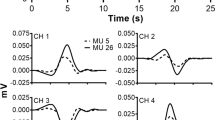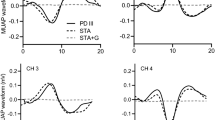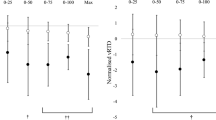Abstract
Purpose
To examine the effects of 10 weeks of endurance cycling training on mechanomyographic amplitude (MMGRMS)–torque relationships and muscle cross-sectional area (mCSA) of the vastus lateralis (VL) for 10 sedentary males (Age ± SD; 20.2 ± 1.9 years) and 14 sedentary females (21.9 ± 5.3 years).
Methods
Participants performed maximal voluntary contractions (MVCs) and an isometric ramp up muscle action to 70% MVC of the knee extensors before (PRE) and after training at the same absolute pre-treatment submaximal torque (POSTABS). MMG was recorded from the VL and b terms were calculated from the natural log-transformed MMGRMS–torque relationships for each subject. mCSA was determined with ultrasonography.
Results
Cycling decreased MVCs from pre- (168.10 ± 58.49 Nm) to post-training (160.78 ± 58.39 Nm; p = 0.005) without changes in mCSA. The b terms were greater for POSTABS (0.623 ± 0.204) than PRE (0.540 ± 0.226; p = 0.012) and for males (0.717 ± 0.171) than females (0.484 ± 0.168; p = 0.003). mCSA was correlated with the b terms for PRE (p < 0.001, r = 0.674) and POSTABS (p = 0.020, r = 0.471).
Conclusion
The decrease in MVC and increase in MMGRMS (b terms) post-training suggests increased motor unit (MU) recruitment to match pre-training torques. The greater acceleration in the b terms by males may reflect sex-related differences in fiber-type area. MMGRMS–torque relationships during a high-intensity contraction provided insight on MU activation strategies following endurance training and between sexes. Furthermore, the findings suggest a relationship between MMGRMS and muscle size.







Similar content being viewed by others
Abbreviations
- ANOVA:
-
Analysis of variance
- HRR:
-
Heart rate reserve
- mCSA:
-
Muscle cross sectional area
- MHC:
-
Myosin heavy chain
- MMGRMS :
-
Mechanomyographic amplitude
- MVC:
-
Maximal voluntary contraction
- MU:
-
Motor unit
- POSTABS :
-
Post absolute torque level
- sFAT:
-
Subcutaneous fat
- VL:
-
Vastus lateralis
- VO2MAX :
-
Maximal aerobic capacity
References
Akataki K, Mita K, Watakabe M, Itoh K (2003) Mechanomyographic responses during voluntary ramp contractions of the human first dorsal interosseous muscle. Eur J Appl Physiol 89(6):520–525. https://doi.org/10.1007/s00421-003-0835-1
Amstrong L, Whaley M, Brubaker P, Otto R (2005) ACSM’Guidelines for exercise testing and prescription. In: Lippincott Williams & Wilkins, American College of Sport Medicine, Guidelines Skin Fold M easurement, Philadelphia PA
Bottinelli R, Canepari M, Pellegrino M, Reggiani C (1996) Force-velocity properties of human skeletal muscle fibres: myosin heavy chain isoform and temperature dependence. J Physiol 495(2):573–586
Burke R, Levine D, Tsairis P, Zajac Iii F (1973) Physiological types and histochemical profiles in motor units of the cat gastrocnemius. J Physiol 234(3):723–748
Canepari M, PellegrinoD’antona MG, Bottinelli R (2010) Skeletal muscle fibre diversity and the underlying mechanisms. Acta Physiol 199(4):465–476
Cartwright MS, Demar S, Griffin LP, Balakrishnan N, Harris JM, Walker FO (2013) Validity and reliability of nerve and muscle ultrasound. Muscle Nerve 47(4):515–521
Coburn JW, Housh TJ, Cramer JT, Weir JP, Miller JM, Beck TW, Malek MH, Johnson GO (2005) Mechanomyographic and electromyographic responses of the vastus medialis muscle during isometric and concentric muscle actions. J Strength Cond Res 19(2):412–420. https://doi.org/10.1519/15744.1
Cooper MA, Herda TJ (2014) Muscle-related differences in mechanomyography–force relationships are model-dependent. Muscle Nerve 49(2):202–208
Cooper MA, Herda TJ, Vardiman JP, Gallagher PM, Fry AC (2014) Relationships between skinfold thickness and electromyographic and mechanomyographic amplitude recorded during voluntary and non-voluntary muscle actions. J Electromyogr Kinesiol 24(2):207–213
De Luca CJ, Erim Z (1994) Common drive of motor units in regulation of muscle force. Trends Neurosci 17(7):299–305
De Luca CJ, Hostage EC (2010) Relationship between firing rate and recruitment threshold of motoneurons in voluntary isometric contractions. J Neurophysiol 104(2):1034–1046
De Luca C, Kline J (2011) Influence of proprioceptive feedback on the firing rate and recruitment of motoneurons. J Neural Eng 9(1):016007
De Luca C, LeFever R, McCue M, Xenakis A (1982) Behaviour of human motor units in different muscles during linearly varying contractions. J Physiol 329(1):113–128
Farina D, Merletti R, Enoka RM (2004) The extraction of neural strategies from the surface EMG. J Appl Physiol 96(4):1486–1495
Garnett R, O’donovan M, Stephens J, Taylor A (1979) Motor unit organization of human medial gastrocnemius. J Physiol 287(1):33–43
Harber MP, Gallagher PM, Creer AR, Minchev KM, Trappe SW (2004) Single muscle fiber contractile properties during a competitive season in male runners. Am J Physiol-Regul Integr Comparative Physiol 287(5):R1124–R1131
Herda TJ, Ryan ED, Beck TW, Costa PB, DeFreitas JM, Stout JR, Cramer JT (2008) Reliability of mechanomyographic amplitude and mean power frequency during isometric step and ramp muscle actions. J Neurosci Methods 171(1):104–109
Herda TJ, Weir JP, Ryan ED, Walter AA, Costa PB, Hoge KM, Beck TW, Stout JR, Cramer JT (2009) Reliability of absolute versus log-transformed regression models for examining the torque-related patterns of response for mechanomyographic amplitude. J Neurosci Methods 179(2):240–246
Herda TJ, Housh TJ, Fry AC, Weir JP, Schilling BK, Ryan ED, Cramer JT (2010) A noninvasive, log-transform method for fiber type discrimination using mechanomyography. J Electromyogr Kinesiol 20(5):787–794
Herda TJ, Siedlik JA, Trevino MA, Cooper MA, Weir JP (2015) Motor unit control strategies of endurance-versus resistance-trained individuals. Muscle Nerve 52(5):832–843
Howald H, Hoppeler H, Claassen H, Mathieu O, Straub R (1985) Influences of endurance training on the ultrastructural composition of the different muscle fiber types in humans. Pflügers Archiv 403(4):369–376
Karvonen MJ (1957) The effects of training on heart rate: a longitudinal study. Ann Med Exp Biol Fenn 35:307–315
Kraemer WJ, Patton JF, Gordon SE, Harman EA, Deschenes MR, Reynolds K, Newton RU, Triplett NT, Dziados JE (1995) Compatibility of high-intensity strength and endurance training on hormonal and skeletal muscle adaptations. J Appl Physiol 78(3):976–989
Medicine ACoS ACSM’s guidelines for exercise testing and prescription (2005) Lippincott Williams & Wilkins, Baltimore
Lounana J, Campion F, Noakes TD, Medelli J (2007) Relationship between% HRmax,% HR reserve,% VO2max, and% VO2 reserve in elite cyclists. Med Sci Sports Exerc 39(2):350–357
Martinez-Valdes E, Falla D, Negro F, Mayer F, Farina D (2017) Differential motor unit changes after endurance or high-intensity interval training. Med Sci Sports Exerc 49(6):1126–1136
Miller AEJ, MacDougall J, Tarnopolsky M, Sale D (1993) Gender differences in strength and muscle fiber characteristics. Eur J Appl Physiol 66(3):254–262
Nonaka H, Mita K, Akataki K, Watakabe M, Itoh Y (2006) Sex differences in mechanomyographic responses to voluntary isometric contractions. Med Sci Sports Exerc 38(7):1311–1316
Orizio C (1993) Muscle sound: bases for the. J Crit Rev Biomed Eng 21(3):201–243
Orizio C, Perini R, Veicsteinas A (1989) Muscular sound and force relationship during isometric contraction in man. Eur J Appl Physiol 58(5):528–533
Orizio C, Liberati D, Locatelli C, De Grandis D, Veicsteinas A (1996) Surface mechanomyogram reflects muscle fibres twitches summation. J Biomech 29(4):475–481
Ryan ED, Beck TW, Herda TJ, Hartman MJ, Stout JR, Housh TJ, Cramer JT (2008) Mechanomyographic amplitude and mean power frequency responses during isometric ramp vs step muscle actions. J Neurosci Methods 168(2):293–305
Schantz P, Randall Fox E, Norgren P, Tydén A (1981) The relationship between the mean muscle fibre area and the muscle cross-sectional area of the thigh in subjects with large differences in thigh girth. Acta Physiol Scand 113:537–539
Schantz P, Randall-Fox E, Hutchison W, Tydén A, Åstrand PO (1983) Muscle fibre type distribution, muscle cross-sectional area and maximal voluntary strength in humans. Acta Physiol Scand 117(2):219–226
Scott JM, Martin DS, Ploutz-Snyder R, Caine T, Matz T, Arzeno NM, Buxton R, Ploutz-Snyder L (2012) Reliability and validity of panoramic ultrasound for muscle quantification. Ultrasound Med Biol 38(9):1656–1661
Staron RS, Hagerman FC, Hikida RS, Murray TF, Hostler DP, Crill MT, Ragg KE, Toma K (2000) Fiber type composition of the vastus lateralis muscle of young men and women. J Histochem Cytochem 48(5):623–629
Swain DP (2000) Energy cost calculations for exercise prescription. Sports Med 30(1):17–22
Trevino MA, Herda TJ (2015) Mechanomyographic mean power frequency during an isometric trapezoid muscle action at multiple contraction intensities. Physiol Meas 36(7):1383
Trevino MA, Herda TJ (2016) The effects of chronic exercise training status on motor unit activation and deactivation control strategies. J Sports Sci 34(3):199–208
Trevino MA, Herda TJ, Fry AC, Gallagher PM, Vardiman JP, Mosier EM, Miller JD (2016a) The influence of myosin heavy chain isoform content on mechanical behavior of the vastus lateralis in vivo. J Electromyogr Kinesiol 28:143–151
Trevino MA, Herda TJ, Fry AC, Gallagher PM, Vardiman JP, Mosier EM, Miller JD (2016b) Influence of the contractile properties of muscle on motor unit firing rates during a moderate-intensity contraction in vivo. J Neurophysiol 116(2):552–562
Trevino M, Sterczala A, Miller J, Wray M, Dimmick H, Ciccone A, Weir J, Gallagher P, Fry A, Herda T (2019) Sex-related differences in muscle size explained by amplitudes of higher-threshold motor unit action potentials and muscle fibre typing. Acta Physiol 225(4):e13151
Vila-Chã C, Falla D, Farina D (2010) Motor unit behavior during submaximal contractions following six weeks of either endurance or strength training. J Appl Physiol 109(5):1455–1466
Vila-Cha C, Falla D, Correia MV, Farina D (2012) Adjustments in motor unit properties during fatiguing contractions after training. Med Sci Sports Exerc 2012:66
Zwarts MJ, Keidel M (1991) Relationship between electrical and vibratory output of muscle during voluntary contraction and fatigue. Muscle Nerve 14(8):756–761
Acknowledgements
We would like to thank P.R. Maier and J.D. Lippman who aided in data collection and analysis, as well as each subject for their selfless participation.
Funding
This publication was made possible by a National Strength and Conditioning Association Foundation (NSCAF) Graduate Research Doctoral Grant FND0074499 and a University of Kansas Doctoral Student Research Fund (DSRF) grant.
Author information
Authors and Affiliations
Contributions
MAT and TJH designed the experiments. SAS, MAT, AJS, JDM, MEP, HLD, and JAD conducted the experiments. SAS, MAT, TJH, AJS, JDM, MEP, HLD, and JAD analyzed the data. SAS and MAT wrote the manuscript. SAS and MAT edited and revised the manuscript. All authors approved the final version of the manuscript submitted for publication and agree to be accountable for all aspects of the work. All persons designated as authors qualify for authorship, and all those who qualify for authorship are listed.
Corresponding author
Ethics declarations
Conflict of interest
The authors declare they have no competing interests.
Additional information
Communicated by Toshio moritani.
Publisher's Note
Springer Nature remains neutral with regard to jurisdictional claims in published maps and institutional affiliations.
Rights and permissions
About this article
Cite this article
Sontag, S.A., Trevino, M.A., Herda, T.J. et al. Endurance training alters motor unit activation strategies for the vastus lateralis, yet sex-related differences and relationships with muscle size remain. Eur J Appl Physiol 121, 1367–1377 (2021). https://doi.org/10.1007/s00421-021-04622-7
Received:
Accepted:
Published:
Issue Date:
DOI: https://doi.org/10.1007/s00421-021-04622-7




